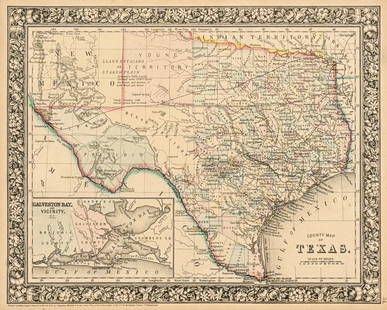
Manuscript Chart of Neah Bay
Similar Sale History
View More Items in Maps & AtlasesRelated Maps & Atlases
More Items in Maps & Atlases
View MoreRecommended Transportation & Travel Collectibles
View More


Item Details
Description
Manuscript Chart of Neah Bay. James Allen Scarborough (1805-1852). Manuscript map. c. 1849. 11 1/2 x 19 3/4 inches sheet. Fine manuscript chart of Neah Bay, now part of the Makah Reservation in Washington at the mouth of the Strait of Juan de Fuca near the border with Canada, extending from Point Hilcome in the west to Sail Rock in the east, showing the 'Spanish Village' of Neah, Mena, and Scarborough's Point, Why Had Da island, sandbanks, and soundings, with a large compass rose upper right, comments about tides and a scale (old folds, margins with one or two nicks and tears). A very detailed map of an area first published by Charles Wilkes in his map "St. Juan Harbour, Straits of Fuca, Vancouver Island. Scarborough Harbour, Port Discovery, Straits of Fuca, Oregon Territory", as part of his "Narrative of the United States Exploring Expedition. During the years 1838, 1839, 1840, 1841, 1842", Philadelphia: Lea and Blanchard, 1845. There are some similarities (ie Point Hilcome), but also distinct differences in the place-names: Wah Had Da island is named by Wilkes as Neah Island, Mena is Village Point, and Scarborough Point is Sail Rock Point. The name "Neah" refers to how the Makah Chief Dee-ah, pronounced Neah in the Klallam language, but other names had been previously used for the bay. In August of 1788 Captain Charles Duncan, a British trader, charted a bay at the same location, but did not give it a name. In 1790 Manuel Quimper took possession of the bay for Spain and named it "Bahía de Núñez Gaona" in honor of Alonso Núñez de Haro y Peralta, viceroy of New Spain. In 1792 Salvador Fidalgo began to build a Spanish fort on Neah Bay, during which time George Vancouver charted but did not stop at the bay. American traders called Neah Bay "Poverty Cove". In 1841 the United States Exploring Expedition under Charles Wilkes mapped the region and named Neah Bay "Scarborough Harbour" in honor of Captain Scarborough of the Hudson's Bay Company, who created this map, and who assisted Wilkes' expedition. The Wilkes map contained the first use of the word "Neah", but only for the bay's island. The bay was first called Neah in 1847 by Captain Henry Kellett during his reorganization of the British Admiralty charts. Kellett spelled it "Neeah Bay". "Neah Harbour is but a small indentation in the coast, which is partly sheltered on the northeast by Neah Island. It is the position where the Spaniards attempted to establish themselves in 1792, and which they called Port Nunez Gaona. The remains of an old fort are still to be perceived, and some bricks were found that were supposed to have belonged to it . Water is to be obtained here in some quantity, and a small vessel would have no difficulty in getting enough. It offers a tolerably safe anchorage, though somewhat exposed to the northwest gales; yet by anchoring well in, which a small vessel may do, protection even from these gales might be had. (Wilkes, volume IV, page 483) The Cadboro was built and owned by the Hudson's Bay Company, in Rye, Sussex, in 1824, with one deck and two masts, she was schooner-rigged, with a standing bowsprit. She "sailed from London on her first trip in the fall of 1826, rounding Cape Horn, and arriving at Fort Vancouver, Oregon Territory, in the spring of the following year, bringing, beside her crew of picked men, several new servants for the Hudson's Bay Company...The Cadboro was the crack vessel of the Pacific Coast. She carried six guns, thirty-five men, and made a barrel of money for the Hudson's Bay Company on her trading trips between Nootka Sound and Fort Vancouver... Capt. James Scarborough succeeded Captain Brotchie and continued sailing her for ten years, when in 1848 he gave way to James Sangster... though she did good service until the gold rush in 1858, she was beginning to show age, so in 1860 the company sold her at auction to Captain Howard for $2,450. Her new owner operated her as a coal and lumber vessel between Victoria and neighboring ports until October, 1862, when during a trip up the Sound with a cargo of lumber she was caught in a gale a few miles from Port Angeles, sprang a leak, and was run ashore by the captain in charge, where the beating of the surf soon knocked her to pieces". (Wright: "Lewis & Dryden's Marine History of the Pacific Northwest", 1895, page 13). In December of 1843 Scarborough, who had joined the Hudson's Bay Company in 1829, settled further south at Chinook Point, subsequently Scarborough Hill, on the Columbia River in what is now Fort Columbia, Pacific County, Washington, where Chief Concomly (fl 1810-1830) and his six wives had once lived, and stayed there until his death in 1852. Scarborough had retired from the Hudson’s Bay Company in July, 1850, after 20 years of service. He moved permanently to his land and devoted himself to farming, commercial salmon fishing, and piloting mail steamers over the Columbia River bar. (Virginia Story at HistoryLink).
Buyer's Premium
- 27%
Manuscript Chart of Neah Bay
Estimate $5,000 - $7,000
2 bidders are watching this item.
Shipping & Pickup Options
Item located in New York, NY, usSee Policy for Shipping
Payment

Related Searches
TOP





























































